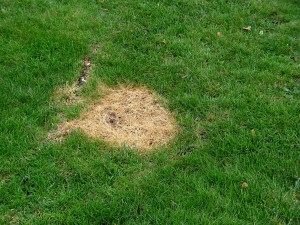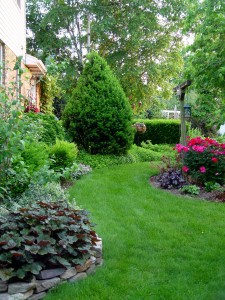Feeding the Lawn
October 18th, 2007
The lawn is a hungry creature.
To be the lush, thick, dark-green carpet that guys drool over, a lawn needs a steady diet of nitrogen, varying amounts of other nutrients and occasional doses of herbicides and insecticides.
As public opinion drifts toward the green side in yard practices, more people are wondering:
* Do I really need all of that stuff?
* Could those “environmental wackos” be right about lawn chemicals polluting wells and waterways?
* And isn’t there some kind of compromise that lets me have a decent lawn without spending so much time and money?
The short answers:
1.) No, you don’t have to fertilize four or five times a year or routinely use herbicides and insecticides. It depends on how thick, green and perfect you want the lawn to be and what kind of fertilizers you use.
2.) Yes, you can pollute whether you’re using a bag of “chemical” fertilizer or a bag of poo-fortified “organic” fertilizer.
3.) Yes, you’ve got lots of choices, whether you do it yourself or hire a company. Again, it depends on how perfect you want the lawn to be.
The bottom line is that you can go green and still have green.
I’ve seen yards where people have done absolutely nothing, and there’s still grass, albeit with clover, dandelions and other weeds mixed in.
The so-called organic approach lets you ratchet it up several notches, giving you a reasonably nice lawn without moving into perfection mode.
Let’s just tackle fertilizing, which is the final lawn job left this year (assuming you still have lawn left after grubs, sod webworms, chinchbugs and drought).
You’ve got a choice of three main ways to do the deed.
One is the post-World-War-II chemical approach that uses synthetic materials, primarily fusing the hydrogen in natural gas with nitrogen in the air to make ammonia, which is then bagged in granular form.
The second approach is what’s commonly called “organic.” This relies on natural sources to supply nutrients, such as dried manures, blood meal, cottonseed meal, rock phosphates, kelp and fish products.
The third and newest approach is using slow-release nitrogen sources – either products that have been coated like timed-release medicines or ones that break down slowly. This is kind of a hybrid in that they’re still synthetic products, only they act more like natural fertilizers in the ground.
In my opinion, none of these are inherently “good” or “bad.” All have pros and cons.
One advantage of organic fertilizers is that they have to break down in order for the nutrients to be released in a form that the grass roots can use. This takes place slowly and means you only have to fertilize twice a year.
This breakdown also correlates nicely with the times that lawns need them most.
When the soil warms in spring and rain increases, organic fertilizer breaks down faster. When the rains shut off in summer and soil microbe activity slows in heat and drought, organic fertilizer breaks down more slowly.
By contrast, traditional chemical fertilizers are water soluble and go to work quickly. The lawn greens up quickly and has plenty of nutrients to grow and fill in.
The tradeoff is that the bulk of the nitrogen in these fertilizers is used up, leached out of the root zone or carried away by runoff in 6 to 8 weeks. That’s why you have to apply them four to five times per season.
Three other benefits of organics:
1.) They don’t cause growth spurts after feedings that lead to excess mowing.
2.) They’re less likely than chemical fertilizers to encourage thatch problems in the lawn. (Thatch is that dead, matted layer between the soil surface and grass blades.)

A dead spot in the lawn caused by fertilizer that spilled while the gardener was filling the spreader. It overdosed this spot with nitrogen and burned it.
3.) They don’t cause the streaking that sometimes happens when fast-acting chemical fertilizers aren’t evenly applied or cause brown spots if you spill some while trying to fill your spreader.
4.) You’re less likely to overdo it, thereby increasing the odds of excess-nitrogen-related lawn diseases such as leaf spot and brown patch.
The main rap against organics is that it doesn’t give lawns the quick green-ups and thick, rich performance that some people want.
It’s much like the difference between a body-builder and someone who lifts weights at a health club.
Bodybuilders push themselves to the limit, stack on as much additional weight as they can handle and typically take supplements to maximize muscle-building nutrition.
The health-club-goer lifts more moderate weights and ends up reasonably strong and fit but not enough to win any Mr. America competitions.
Two other drawbacks to organic fertilizers:
* Most of them have a manure smell or other “off” odor, although that typically dissipates in a few days.
* Organics are usually more expensive per bag than synthetic fertilizer. But since you’re buying it only twice a year instead of four to five times, it’s less expensive overall.
Option 3 – slow-release fertilizer – is designed to give organic advantages to synthetic products.
Look on the product analysis chart of most lawn fertilizers these days and you’re likely to see a breakdown of what percentage of the product’s nitrogen is “slow release.”
Synthetic nitrogen sources such as methylene urea and IBDU break down over a period of 12 to 16 weeks. When you blend those with water-soluble nitrogen, the result is a product that gives quick greening but then continues to feed gradually for months.
Bottom line is that you can cut applications to the same twice-a-year regimen (spring and fall) as an organic program.
As with organics, products that are high in slow-release nitrogen reduce the amount of fertilizer that can run off because you’re applying less of it less often.
Choices, choices.
That’s why you see a mountain of bags of a dozen different kinds at the home and garden centers.
Any fertilizer can be harmful to the environment if it’s applied to excess or applied at the wrong time or in the wrong way.
If you use a broadcast spreader and accidentally scatter granules on the driveway or sidewalk, most of the nutrients are going to end up in the storm sewers, whether it’s synthetic ammonia or good, ol’ dried chicken manure.
Or if you apply fertilizer on compacted ground right before a torrential rain, much of the fertilizer is going to run off.
If makes sense, above all else, to determine if your lawn really needs nutrients, and if so, which ones and how much.
The only way to determine that is to test the soil’s nutrient levels and pH (a measure of soil acidity).
County Extension offices and most garden centers have mail-in, do-it-yourself Penn State soil test kits. You take samples from throughout the area, combine them, dry the composite and send it off. A week or two later, you’ll get a report. (Other private labs offer the same service.)
Tests don’t have to be done every year, but they’re a good idea at the beginning of any program and then every three to four years.
You may find you really don’t need to apply that lime you were about to buy. Or you may find you don’t need more of a particular nutrient you’ve been applying regularly.
It’s only been recently found, for example, that lawns need a lot less phosphorus than thought. That’s one of the big three nutrients routinely found in most fertilizers (the middle number on the three-digit formula on bags).
Phosphorus leaches very slowly from the ground, meaning only small amounts of it are usually needed in lawn fertilizers. When excess is added, some leaves the property in rain runoff, where it has been implicated as an important contributor to harmful buildup of algae in waterways.
Several fertilizer manufacturers have begun offering phosphorus-free lawn fertilizers for lawns that already have enough nitrogen.
But the only way you’d know if your lawn is one of those is by testing.
Intrigued by organic lawn care?
There’s a new book that covers the topic thoroughly: “The Organic Lawn Care Manual” by Paul Tukey (Storey Publishing, $19.95).
A new related organization called SafeLawns is dedicated to convincing homeowners to switch away from chemical-heavy lawn-care regimens. Its web site is www.safelawns.org.








